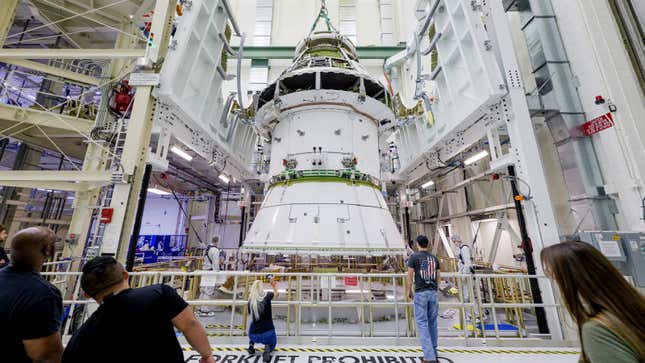NASA’s Return To The Moon Just Got One Giant Leap Closer

NASA has just taken delivery of one of the key components of the new rocket that will fly astronauts into orbit around the moon next year. The central piece of the new Space Launch System has arrived in Florida, where it will soon be assembled to begin tests and checks before the planned mission, which could launch in September 2025.
‘Twister’ Remains The Greatest Car Commercial Of All Time
This week, NASA took delivery of the core stage of the SLS at Kennedy Space Center following a week-long voyage from its assembly plant in New Orleans, reports Ars Technica. The core plus two rocket boosters and an upper stage will form the space craft that takes NASA astronauts Reid Wiseman, Victor Glover, Christina Koch, and Canadian mission specialist Jeremy Hansen on a mission to the far side of the moon in September 2025. As Ars Technica reports:
“The core is the backbone of SLS, and it’s the backbone of the Artemis mission,” said Matthew Ramsey, NASA’s mission manager for Artemis II. “We’ve been waiting for the core to get here because all the integrated tests and checkouts that we do have to have the core stage. It has the flight avionics that drive the whole system. The boosters are also important, but the core is really the backbone for Artemis. So it’s a big day.”
Ramsey told Ars that ground teams hope to begin stacking the rocket’s two powerful solid rocket boosters on NASA’s mobile launcher platform in September. Each booster, supplied by Northrop Grumman, is made of five segments with pre-packed solid propellant and a nose cone. All the pieces for the SLS boosters are at Kennedy and ready for stacking, Ramsey said.
The SLS upper stage, built by United Launch Alliance, is also at the Florida launch site. Now, the core stage is at Kennedy. In August or September, NASA plans to deliver the two remaining elements of the SLS rocket to Florida. These are the adapter structures that will connect the core stage to the upper stage, and the upper stage to the Orion spacecraft.
The rocket spent a week travelling from New Orleans to Florida. Photo: NASA
Assembly to complete SLS is no small task, and NASA will rely on a special heavy duty crane inside its Vehicle Assembly Building to do most of the heavy lifting, the agency explained in a recent blog post. The crane will start by hoisting the sections of the boosters into place before the 212-foot core stage is lowered between them.
NASA hopes to have these stages complete around December 2025, before it can continue with the addition of the upper stage and finally the Orion spacecraft that will bring the astronauts back home following their flight around the dark side of the moon.
It’s a delicate process that will include all manner of safety checks and tests along the way. If the Artemis 2 flight around the moon proves successful, the next step will be a return to the lunar surface, which NASA is targeting with Artemis 3.

The Orion space craft will bring the astronauts back to Earth. Photo: NASA
The third mission doesn’t have a launch date yet, but NASA and its contractors are already working on the components of the rocket that will take astronauts back to the moon. However, the mission’s actual launch date will be reliant on SpaceX’s plans for a new lunar rover as well as Axiom Space’s work on new spacesuits.



